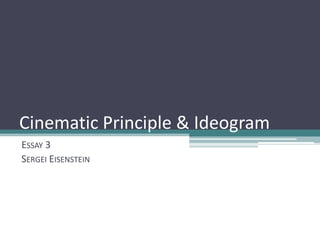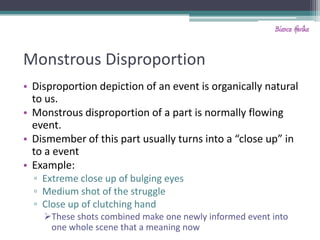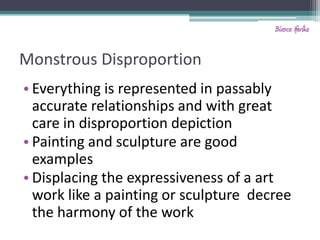Essay 3 sergei eisenstein cinematic principle & ideogram
- 1. Cinematic Principle & Ideogram ESSAY 3 SERGEI EISENSTEIN
- 2. Cinematography ? The art or science of motion picture photography ? Film directors visual collaborator ? Japanese cinema had traits of montages that were never realized ? Hieroglyph to be used as cinematography for writing and the first contingent forms were the chinese by TsˇŻang Chieh Ryan Wariki
- 3. Chinese Cinematography ? Fourteen different styles of handwriting in hieroglyph which then crystallize in itˇŻs present form ? Ancient Chinese Bronzes were formed and created 607 symbols of hsiang cheng remains ? Copulation (combination) of two hieroglyphs series to be known as a product and thus ideogram was formed by combined two depictables to represent the ideal of cinematography Ryan Wariki
- 4. Ryan Wariki Chinese Ideogram Commands Dog + Mouth = To bark Mouth + Child = To scream Mouth + Bird = To sing Knife + Heart = To sorrow ? Thus all this commands are MONTAGE! ? Abstract concept but they are commands
- 5. LaconicForm Laconism helps us with a transition to another point. Japan possesses the laconic form of poetry ˇ°Haikiˇ± (During the Beginning or the 13th Century) In the modern age this is known as ˇ°Haikuˇ± or ˇ°Hokkuˇ± Ayiesha Williams
- 6. Haiku ( ) Haiku are short poems that use sensory language to capture a feeling or image. ˇ°Butterflies are cool in the big, huge, green forest. They fly up so high!ˇ± Ayiesha Williams
- 7. Tanka (¶Ě¸č) Tanka poetry refers to a Japanese five line poem. Tanka translated means ˇ°short song.ˇ± ˇ°The weather is cool It's clear that fall is coming The leaves will soon change The days will become shorter And then winter will fall too.ˇŻˇŻ Ayiesha Williams
- 8. SkarakuˇŻs Faces Skaraku is a creator of the finest prints of the 18th Century. He uses the same expression but these pictures are of a old priest and a young women. Each of his large heads: ? Space between the eyes are little to mock all the faces. ? Nose is twice as long in relation to the eyes. ? Chin stands in no sort of relation to the mouth and the brows. Ayiesha Williams
- 9. Monstrous Disproportion ? Disproportion depiction of an event is organically natural to us. ? Monstrous disproportion of a part is normally flowing event. ? Dismember of this part usually turns into a ˇ°close upˇ± in to a event ? Example: ? Extreme close up of bulging eyes ? Medium shot of the struggle ? Close up of clutching hand ?These shots combined make one newly informed event into one whole scene that a meaning now Bianca Iferika
- 10. Monstrous Disproportion ? Everything is represented in passably accurate relationships and with great care in disproportion depiction ? Painting and sculpture are good examples ? Displacing the expressiveness of a art work like a painting or sculpture decree the harmony of the work Bianca Iferika
- 11. Absolute Realism ? Absolute realism is by no mean the correct form of perception ? It is basically the function of certain forms of social structure ? Ideological uniformity can be developed pictorially in the ranks of colors and design of the guard regimen Bianca Iferika
- 12. Principle of Hieroglyphics ? Principle of creating literary imagery ? Basic principle of depiction ? Lead to theater: ? Splitting into two parts, accordance with function of symbols ? This unite to dual estrangement that sphere into theater Bianca Iferika
- 13. Ideographic ? The most important technique in acting is Ideographic (montage) ? A shot is a single piece of celluiod ? Cemented or put together these shot form montage ? Montage is not a assembly of events but the most important element of anaylsis Bianca Iferika
- 14. Old school film making phrase ? ˇ°Screw by Screw, Brick by Brickˇ± ? This is taught by old school filmmakers ? the analysis of the Phrase ? Particles of a story is linked in a whole dramatic chain ? Then the ideas are expressed and accumulated like a shot-cipher just like a brick Bianca Iferika
- 15. Pudovkin and Eisenstein Pudovkin Montage as linkage of pieces Andrew Abuan Einstein Montage as a collision (Two given factors arises a concept)
- 16. Cinematographic Conflicts ? Montage is CONFLICT ? Conflict of ˇ ? Graphic Directions ? Scales ? Volumes ? Masses ? Depths Andrew Abuan
- 17. Unexpected Conflicts ? Conflicts between an object and its dimension. Conflicts between an event and its duration. ? How? ? Optically distorted lens, and the second by stop- motion or slow-motion Andrew Abuan
- 18. Principle of Optical Counterpoint Conflict ? the sound film of acoustics and optics ? between the frame of the shot and the object Andrew Bridge
- 19. Symphonie Diagonale (1924) Director ¨C Viking Eggeling Perhaps the first experimental animation film Andrew Bridge
- 20. ˇ°directionˇ± of a sequence vs. ˇ° picking-outˇ± by the camera Conflict between the frame of the shot and the object Andrew Bridge




















